Case Study: Standard Chartered Bank's Information System and Strategy
VerifiedAdded on 2020/01/28
|13
|3888
|88
Case Study
AI Summary
This case study examines Standard Chartered Bank's business strategies and the crucial role of its information systems (IS). The report begins with an introduction to the bank and its global operations, followed by an analysis of its generic business strategies, including its mission, objectives, and the use of IS to achieve them, such as maintaining customer information, market trends, and shareholder returns. The study then delves into the bank's business functions and processes, highlighting how IS, including Database Management Systems (DBMS) and Executive Support Systems (ESS), streamline operations and provide vital information to management. The report further explores how Standard Chartered Bank leverages IS to gain a competitive advantage, examining its competitors, and discussing the bank's customer relationship management (CRM) strategies. The creation of business strategy and the role of IS is also discussed. Finally, the case study concludes with a review of key trends in IS and their impact on various business areas, providing a comprehensive overview of how Standard Chartered Bank utilizes technology to maintain its position in the global banking industry.
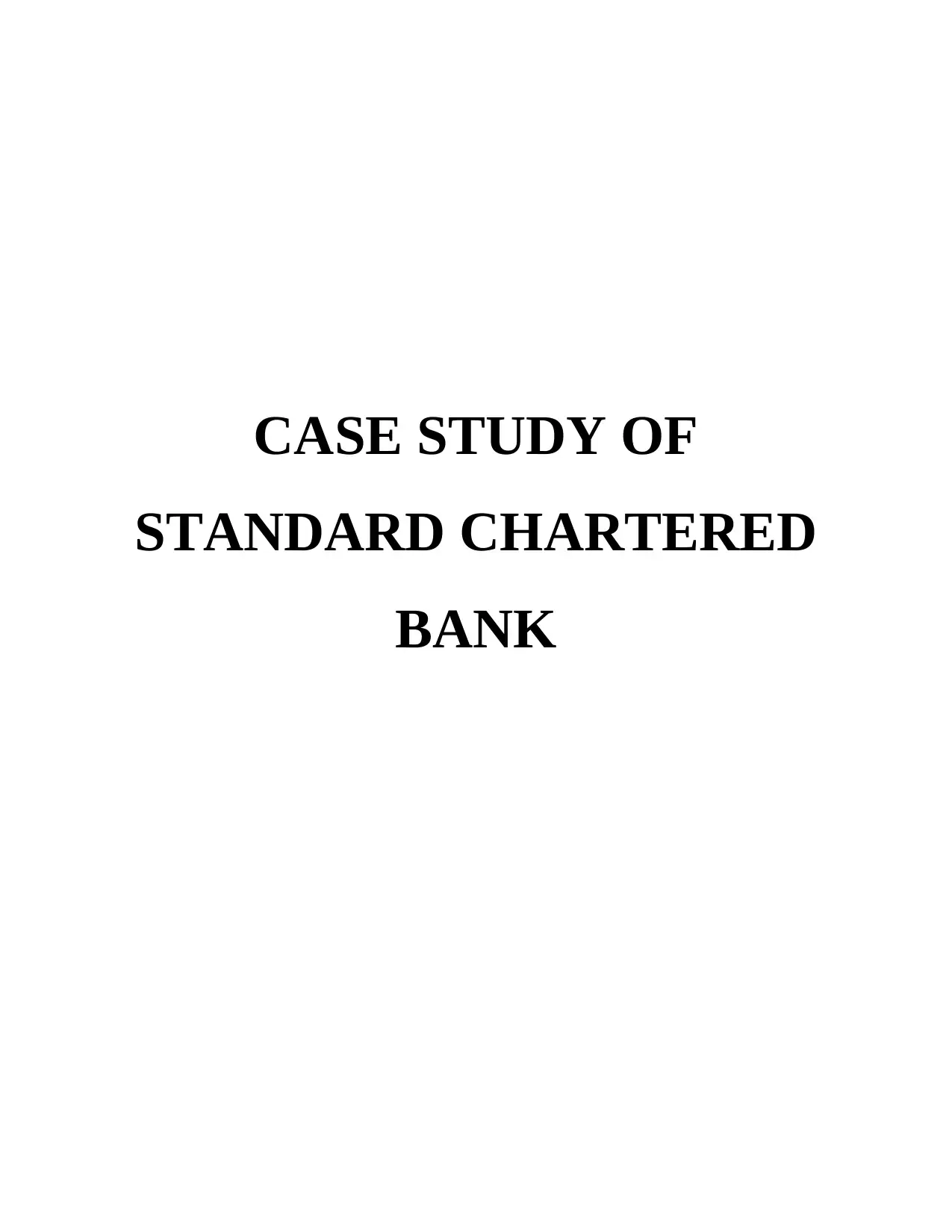
CASE STUDY OF
STANDARD CHARTERED
BANK
STANDARD CHARTERED
BANK
Paraphrase This Document
Need a fresh take? Get an instant paraphrase of this document with our AI Paraphraser
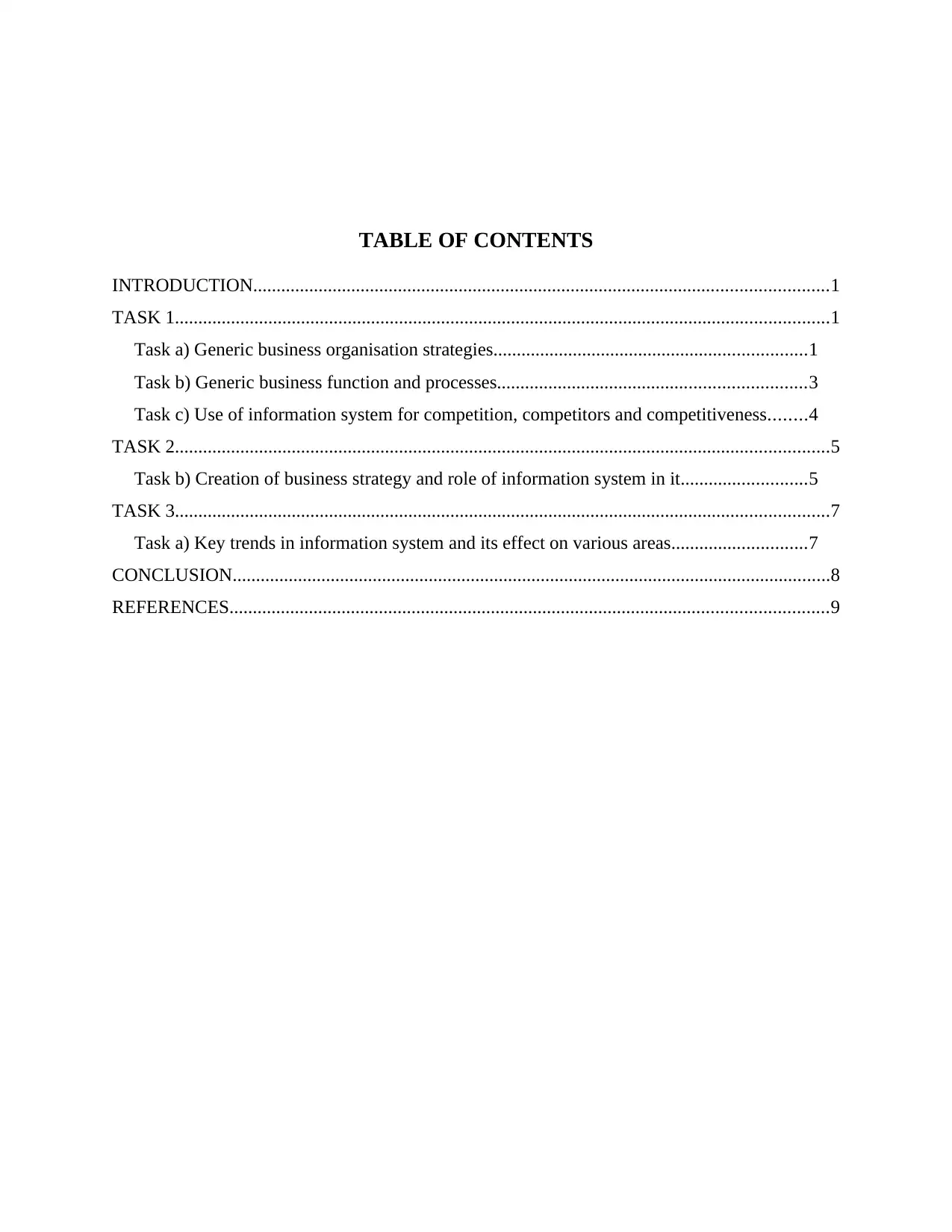
TABLE OF CONTENTS
INTRODUCTION...........................................................................................................................1
TASK 1............................................................................................................................................1
Task a) Generic business organisation strategies...................................................................1
Task b) Generic business function and processes..................................................................3
Task c) Use of information system for competition, competitors and competitiveness........4
TASK 2............................................................................................................................................5
Task b) Creation of business strategy and role of information system in it...........................5
TASK 3............................................................................................................................................7
Task a) Key trends in information system and its effect on various areas.............................7
CONCLUSION................................................................................................................................8
REFERENCES................................................................................................................................9
INTRODUCTION...........................................................................................................................1
TASK 1............................................................................................................................................1
Task a) Generic business organisation strategies...................................................................1
Task b) Generic business function and processes..................................................................3
Task c) Use of information system for competition, competitors and competitiveness........4
TASK 2............................................................................................................................................5
Task b) Creation of business strategy and role of information system in it...........................5
TASK 3............................................................................................................................................7
Task a) Key trends in information system and its effect on various areas.............................7
CONCLUSION................................................................................................................................8
REFERENCES................................................................................................................................9

⊘ This is a preview!⊘
Do you want full access?
Subscribe today to unlock all pages.

Trusted by 1+ million students worldwide
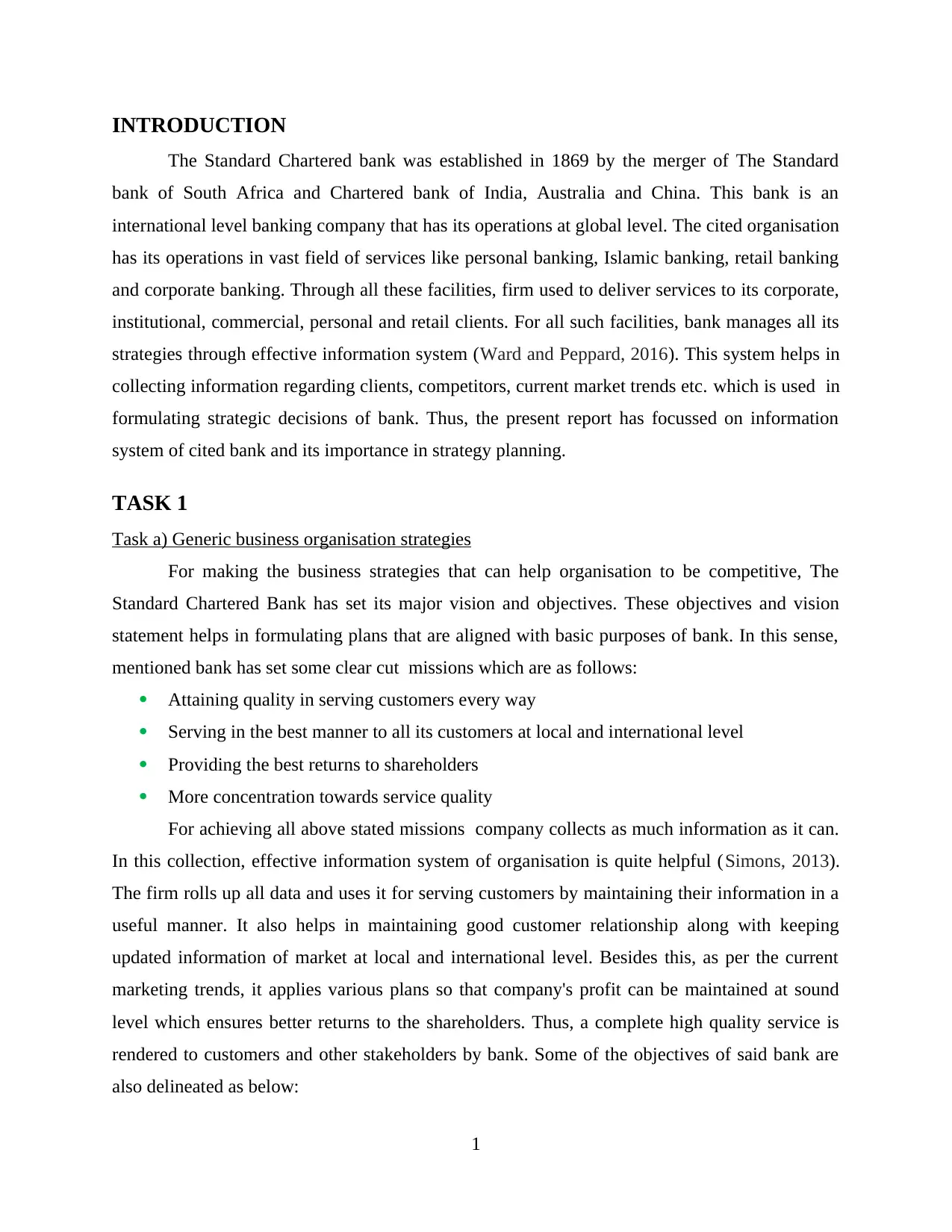
INTRODUCTION
The Standard Chartered bank was established in 1869 by the merger of The Standard
bank of South Africa and Chartered bank of India, Australia and China. This bank is an
international level banking company that has its operations at global level. The cited organisation
has its operations in vast field of services like personal banking, Islamic banking, retail banking
and corporate banking. Through all these facilities, firm used to deliver services to its corporate,
institutional, commercial, personal and retail clients. For all such facilities, bank manages all its
strategies through effective information system (Ward and Peppard, 2016). This system helps in
collecting information regarding clients, competitors, current market trends etc. which is used in
formulating strategic decisions of bank. Thus, the present report has focussed on information
system of cited bank and its importance in strategy planning.
TASK 1
Task a) Generic business organisation strategies
For making the business strategies that can help organisation to be competitive, The
Standard Chartered Bank has set its major vision and objectives. These objectives and vision
statement helps in formulating plans that are aligned with basic purposes of bank. In this sense,
mentioned bank has set some clear cut missions which are as follows:
Attaining quality in serving customers every way
Serving in the best manner to all its customers at local and international level
Providing the best returns to shareholders
More concentration towards service quality
For achieving all above stated missions company collects as much information as it can.
In this collection, effective information system of organisation is quite helpful (Simons, 2013).
The firm rolls up all data and uses it for serving customers by maintaining their information in a
useful manner. It also helps in maintaining good customer relationship along with keeping
updated information of market at local and international level. Besides this, as per the current
marketing trends, it applies various plans so that company's profit can be maintained at sound
level which ensures better returns to the shareholders. Thus, a complete high quality service is
rendered to customers and other stakeholders by bank. Some of the objectives of said bank are
also delineated as below:
1
The Standard Chartered bank was established in 1869 by the merger of The Standard
bank of South Africa and Chartered bank of India, Australia and China. This bank is an
international level banking company that has its operations at global level. The cited organisation
has its operations in vast field of services like personal banking, Islamic banking, retail banking
and corporate banking. Through all these facilities, firm used to deliver services to its corporate,
institutional, commercial, personal and retail clients. For all such facilities, bank manages all its
strategies through effective information system (Ward and Peppard, 2016). This system helps in
collecting information regarding clients, competitors, current market trends etc. which is used in
formulating strategic decisions of bank. Thus, the present report has focussed on information
system of cited bank and its importance in strategy planning.
TASK 1
Task a) Generic business organisation strategies
For making the business strategies that can help organisation to be competitive, The
Standard Chartered Bank has set its major vision and objectives. These objectives and vision
statement helps in formulating plans that are aligned with basic purposes of bank. In this sense,
mentioned bank has set some clear cut missions which are as follows:
Attaining quality in serving customers every way
Serving in the best manner to all its customers at local and international level
Providing the best returns to shareholders
More concentration towards service quality
For achieving all above stated missions company collects as much information as it can.
In this collection, effective information system of organisation is quite helpful (Simons, 2013).
The firm rolls up all data and uses it for serving customers by maintaining their information in a
useful manner. It also helps in maintaining good customer relationship along with keeping
updated information of market at local and international level. Besides this, as per the current
marketing trends, it applies various plans so that company's profit can be maintained at sound
level which ensures better returns to the shareholders. Thus, a complete high quality service is
rendered to customers and other stakeholders by bank. Some of the objectives of said bank are
also delineated as below:
1
Paraphrase This Document
Need a fresh take? Get an instant paraphrase of this document with our AI Paraphraser
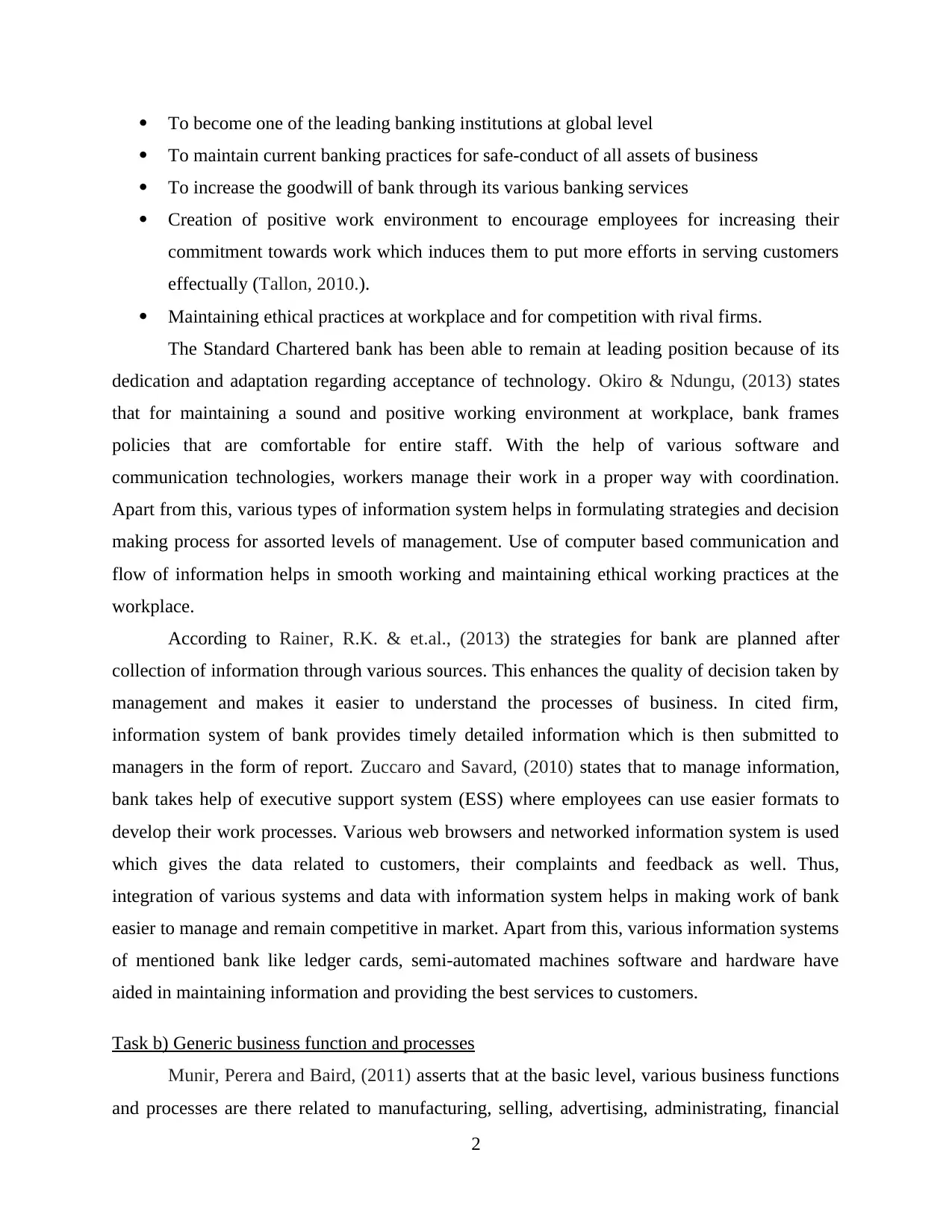
To become one of the leading banking institutions at global level
To maintain current banking practices for safe-conduct of all assets of business
To increase the goodwill of bank through its various banking services
Creation of positive work environment to encourage employees for increasing their
commitment towards work which induces them to put more efforts in serving customers
effectually (Tallon, 2010.).
Maintaining ethical practices at workplace and for competition with rival firms.
The Standard Chartered bank has been able to remain at leading position because of its
dedication and adaptation regarding acceptance of technology. Okiro & Ndungu, (2013) states
that for maintaining a sound and positive working environment at workplace, bank frames
policies that are comfortable for entire staff. With the help of various software and
communication technologies, workers manage their work in a proper way with coordination.
Apart from this, various types of information system helps in formulating strategies and decision
making process for assorted levels of management. Use of computer based communication and
flow of information helps in smooth working and maintaining ethical working practices at the
workplace.
According to Rainer, R.K. & et.al., (2013) the strategies for bank are planned after
collection of information through various sources. This enhances the quality of decision taken by
management and makes it easier to understand the processes of business. In cited firm,
information system of bank provides timely detailed information which is then submitted to
managers in the form of report. Zuccaro and Savard, (2010) states that to manage information,
bank takes help of executive support system (ESS) where employees can use easier formats to
develop their work processes. Various web browsers and networked information system is used
which gives the data related to customers, their complaints and feedback as well. Thus,
integration of various systems and data with information system helps in making work of bank
easier to manage and remain competitive in market. Apart from this, various information systems
of mentioned bank like ledger cards, semi-automated machines software and hardware have
aided in maintaining information and providing the best services to customers.
Task b) Generic business function and processes
Munir, Perera and Baird, (2011) asserts that at the basic level, various business functions
and processes are there related to manufacturing, selling, advertising, administrating, financial
2
To maintain current banking practices for safe-conduct of all assets of business
To increase the goodwill of bank through its various banking services
Creation of positive work environment to encourage employees for increasing their
commitment towards work which induces them to put more efforts in serving customers
effectually (Tallon, 2010.).
Maintaining ethical practices at workplace and for competition with rival firms.
The Standard Chartered bank has been able to remain at leading position because of its
dedication and adaptation regarding acceptance of technology. Okiro & Ndungu, (2013) states
that for maintaining a sound and positive working environment at workplace, bank frames
policies that are comfortable for entire staff. With the help of various software and
communication technologies, workers manage their work in a proper way with coordination.
Apart from this, various types of information system helps in formulating strategies and decision
making process for assorted levels of management. Use of computer based communication and
flow of information helps in smooth working and maintaining ethical working practices at the
workplace.
According to Rainer, R.K. & et.al., (2013) the strategies for bank are planned after
collection of information through various sources. This enhances the quality of decision taken by
management and makes it easier to understand the processes of business. In cited firm,
information system of bank provides timely detailed information which is then submitted to
managers in the form of report. Zuccaro and Savard, (2010) states that to manage information,
bank takes help of executive support system (ESS) where employees can use easier formats to
develop their work processes. Various web browsers and networked information system is used
which gives the data related to customers, their complaints and feedback as well. Thus,
integration of various systems and data with information system helps in making work of bank
easier to manage and remain competitive in market. Apart from this, various information systems
of mentioned bank like ledger cards, semi-automated machines software and hardware have
aided in maintaining information and providing the best services to customers.
Task b) Generic business function and processes
Munir, Perera and Baird, (2011) asserts that at the basic level, various business functions
and processes are there related to manufacturing, selling, advertising, administrating, financial
2
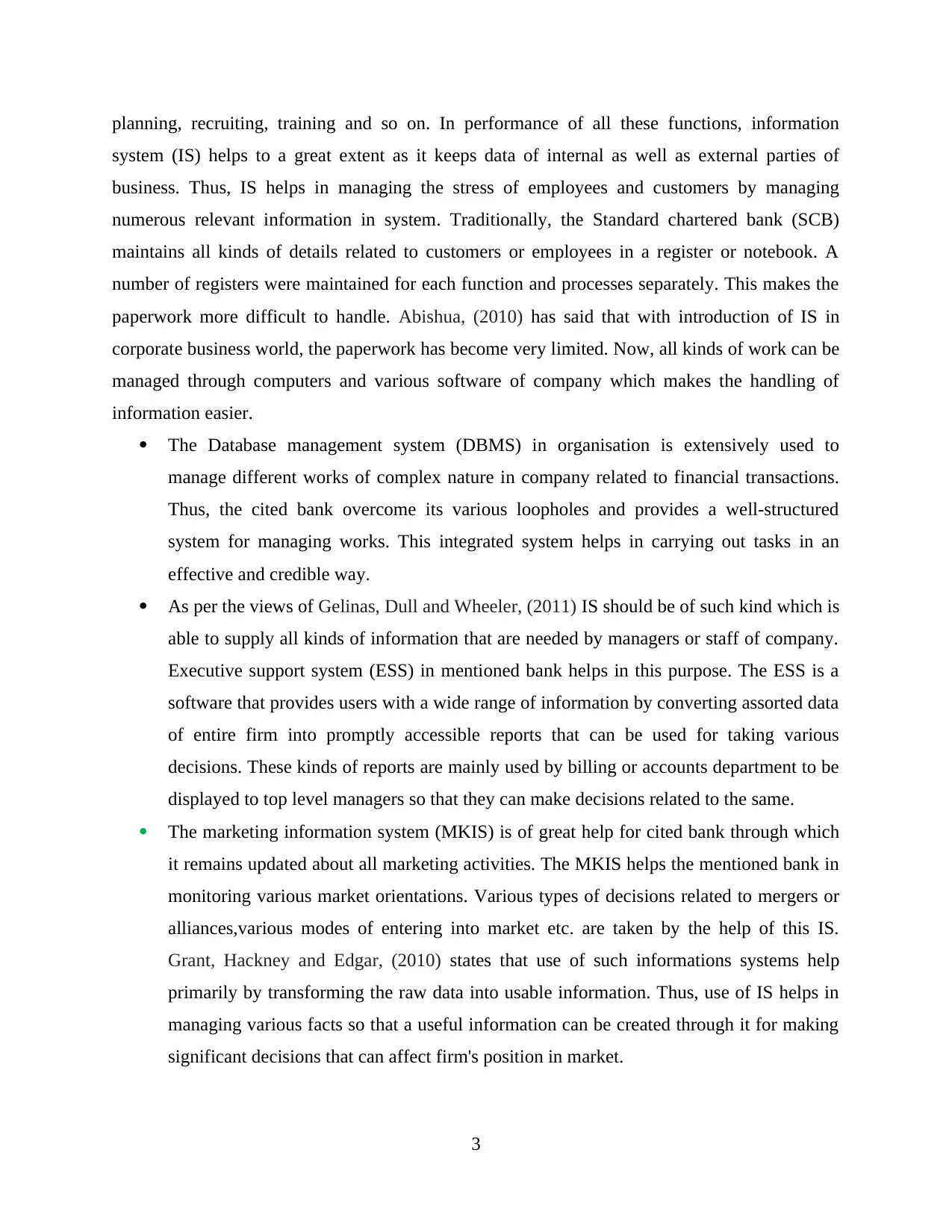
planning, recruiting, training and so on. In performance of all these functions, information
system (IS) helps to a great extent as it keeps data of internal as well as external parties of
business. Thus, IS helps in managing the stress of employees and customers by managing
numerous relevant information in system. Traditionally, the Standard chartered bank (SCB)
maintains all kinds of details related to customers or employees in a register or notebook. A
number of registers were maintained for each function and processes separately. This makes the
paperwork more difficult to handle. Abishua, (2010) has said that with introduction of IS in
corporate business world, the paperwork has become very limited. Now, all kinds of work can be
managed through computers and various software of company which makes the handling of
information easier.
The Database management system (DBMS) in organisation is extensively used to
manage different works of complex nature in company related to financial transactions.
Thus, the cited bank overcome its various loopholes and provides a well-structured
system for managing works. This integrated system helps in carrying out tasks in an
effective and credible way.
As per the views of Gelinas, Dull and Wheeler, (2011) IS should be of such kind which is
able to supply all kinds of information that are needed by managers or staff of company.
Executive support system (ESS) in mentioned bank helps in this purpose. The ESS is a
software that provides users with a wide range of information by converting assorted data
of entire firm into promptly accessible reports that can be used for taking various
decisions. These kinds of reports are mainly used by billing or accounts department to be
displayed to top level managers so that they can make decisions related to the same.
The marketing information system (MKIS) is of great help for cited bank through which
it remains updated about all marketing activities. The MKIS helps the mentioned bank in
monitoring various market orientations. Various types of decisions related to mergers or
alliances,various modes of entering into market etc. are taken by the help of this IS.
Grant, Hackney and Edgar, (2010) states that use of such informations systems help
primarily by transforming the raw data into usable information. Thus, use of IS helps in
managing various facts so that a useful information can be created through it for making
significant decisions that can affect firm's position in market.
3
system (IS) helps to a great extent as it keeps data of internal as well as external parties of
business. Thus, IS helps in managing the stress of employees and customers by managing
numerous relevant information in system. Traditionally, the Standard chartered bank (SCB)
maintains all kinds of details related to customers or employees in a register or notebook. A
number of registers were maintained for each function and processes separately. This makes the
paperwork more difficult to handle. Abishua, (2010) has said that with introduction of IS in
corporate business world, the paperwork has become very limited. Now, all kinds of work can be
managed through computers and various software of company which makes the handling of
information easier.
The Database management system (DBMS) in organisation is extensively used to
manage different works of complex nature in company related to financial transactions.
Thus, the cited bank overcome its various loopholes and provides a well-structured
system for managing works. This integrated system helps in carrying out tasks in an
effective and credible way.
As per the views of Gelinas, Dull and Wheeler, (2011) IS should be of such kind which is
able to supply all kinds of information that are needed by managers or staff of company.
Executive support system (ESS) in mentioned bank helps in this purpose. The ESS is a
software that provides users with a wide range of information by converting assorted data
of entire firm into promptly accessible reports that can be used for taking various
decisions. These kinds of reports are mainly used by billing or accounts department to be
displayed to top level managers so that they can make decisions related to the same.
The marketing information system (MKIS) is of great help for cited bank through which
it remains updated about all marketing activities. The MKIS helps the mentioned bank in
monitoring various market orientations. Various types of decisions related to mergers or
alliances,various modes of entering into market etc. are taken by the help of this IS.
Grant, Hackney and Edgar, (2010) states that use of such informations systems help
primarily by transforming the raw data into usable information. Thus, use of IS helps in
managing various facts so that a useful information can be created through it for making
significant decisions that can affect firm's position in market.
3
⊘ This is a preview!⊘
Do you want full access?
Subscribe today to unlock all pages.

Trusted by 1+ million students worldwide
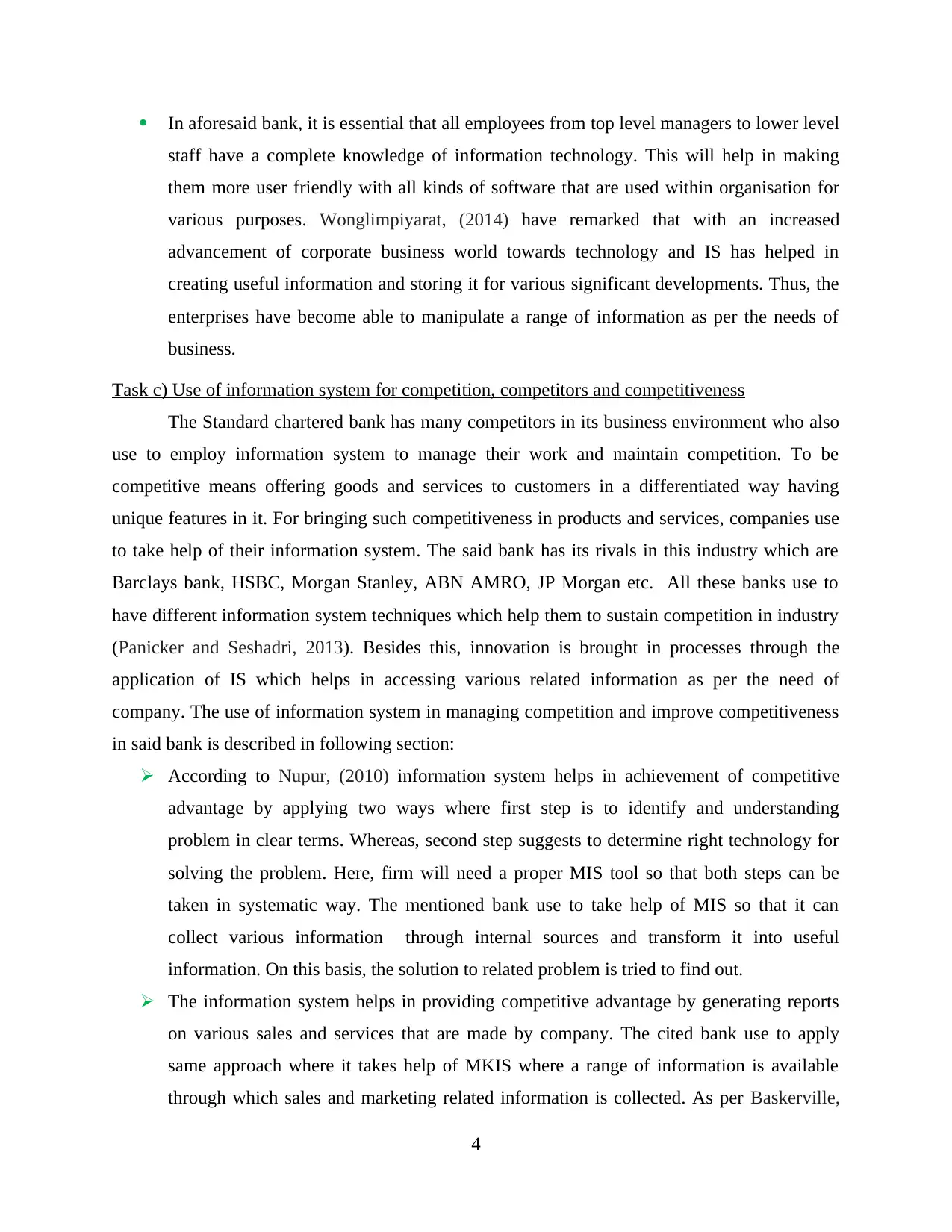
In aforesaid bank, it is essential that all employees from top level managers to lower level
staff have a complete knowledge of information technology. This will help in making
them more user friendly with all kinds of software that are used within organisation for
various purposes. Wonglimpiyarat, (2014) have remarked that with an increased
advancement of corporate business world towards technology and IS has helped in
creating useful information and storing it for various significant developments. Thus, the
enterprises have become able to manipulate a range of information as per the needs of
business.
Task c) Use of information system for competition, competitors and competitiveness
The Standard chartered bank has many competitors in its business environment who also
use to employ information system to manage their work and maintain competition. To be
competitive means offering goods and services to customers in a differentiated way having
unique features in it. For bringing such competitiveness in products and services, companies use
to take help of their information system. The said bank has its rivals in this industry which are
Barclays bank, HSBC, Morgan Stanley, ABN AMRO, JP Morgan etc. All these banks use to
have different information system techniques which help them to sustain competition in industry
(Panicker and Seshadri, 2013). Besides this, innovation is brought in processes through the
application of IS which helps in accessing various related information as per the need of
company. The use of information system in managing competition and improve competitiveness
in said bank is described in following section:
According to Nupur, (2010) information system helps in achievement of competitive
advantage by applying two ways where first step is to identify and understanding
problem in clear terms. Whereas, second step suggests to determine right technology for
solving the problem. Here, firm will need a proper MIS tool so that both steps can be
taken in systematic way. The mentioned bank use to take help of MIS so that it can
collect various information through internal sources and transform it into useful
information. On this basis, the solution to related problem is tried to find out.
The information system helps in providing competitive advantage by generating reports
on various sales and services that are made by company. The cited bank use to apply
same approach where it takes help of MKIS where a range of information is available
through which sales and marketing related information is collected. As per Baskerville,
4
staff have a complete knowledge of information technology. This will help in making
them more user friendly with all kinds of software that are used within organisation for
various purposes. Wonglimpiyarat, (2014) have remarked that with an increased
advancement of corporate business world towards technology and IS has helped in
creating useful information and storing it for various significant developments. Thus, the
enterprises have become able to manipulate a range of information as per the needs of
business.
Task c) Use of information system for competition, competitors and competitiveness
The Standard chartered bank has many competitors in its business environment who also
use to employ information system to manage their work and maintain competition. To be
competitive means offering goods and services to customers in a differentiated way having
unique features in it. For bringing such competitiveness in products and services, companies use
to take help of their information system. The said bank has its rivals in this industry which are
Barclays bank, HSBC, Morgan Stanley, ABN AMRO, JP Morgan etc. All these banks use to
have different information system techniques which help them to sustain competition in industry
(Panicker and Seshadri, 2013). Besides this, innovation is brought in processes through the
application of IS which helps in accessing various related information as per the need of
company. The use of information system in managing competition and improve competitiveness
in said bank is described in following section:
According to Nupur, (2010) information system helps in achievement of competitive
advantage by applying two ways where first step is to identify and understanding
problem in clear terms. Whereas, second step suggests to determine right technology for
solving the problem. Here, firm will need a proper MIS tool so that both steps can be
taken in systematic way. The mentioned bank use to take help of MIS so that it can
collect various information through internal sources and transform it into useful
information. On this basis, the solution to related problem is tried to find out.
The information system helps in providing competitive advantage by generating reports
on various sales and services that are made by company. The cited bank use to apply
same approach where it takes help of MKIS where a range of information is available
through which sales and marketing related information is collected. As per Baskerville,
4
Paraphrase This Document
Need a fresh take? Get an instant paraphrase of this document with our AI Paraphraser
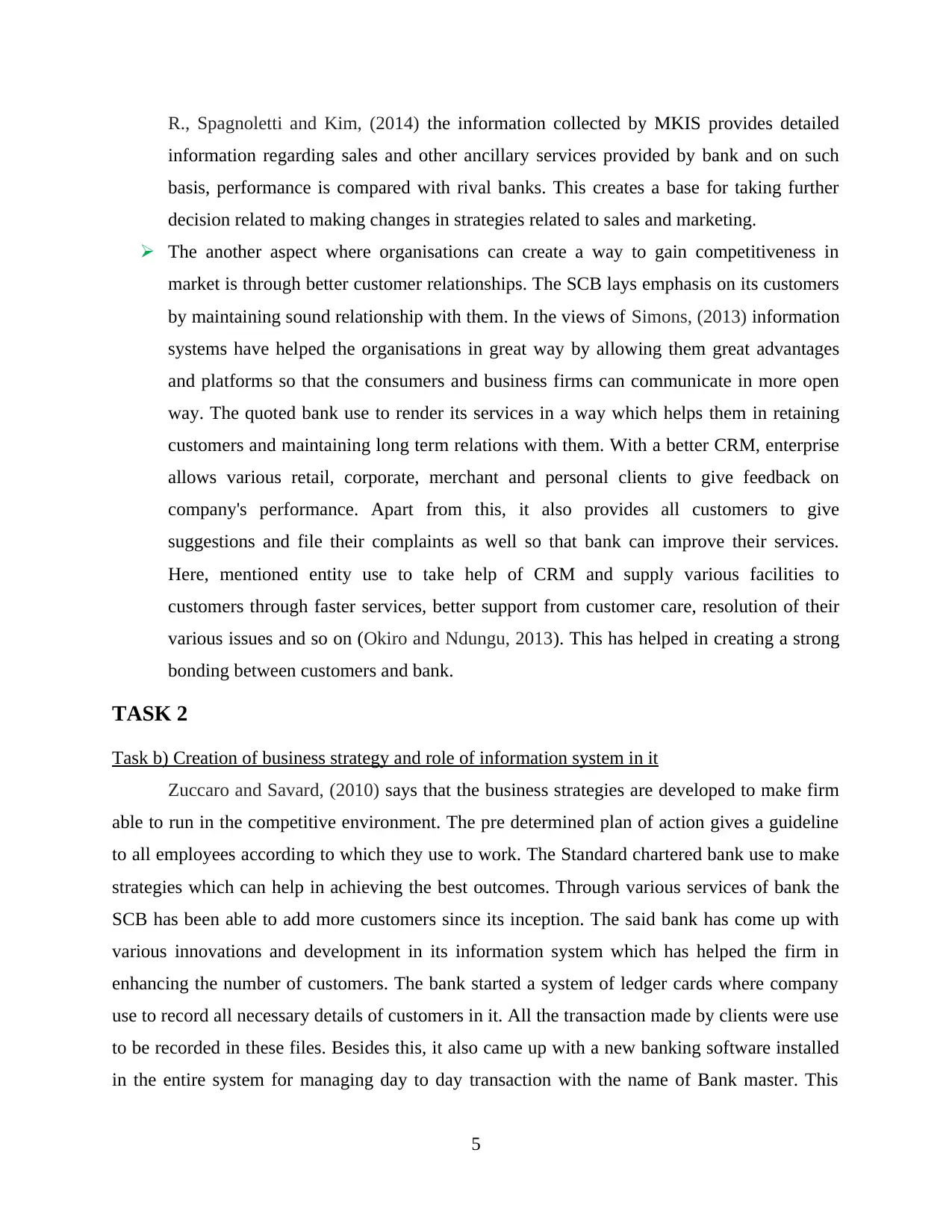
R., Spagnoletti and Kim, (2014) the information collected by MKIS provides detailed
information regarding sales and other ancillary services provided by bank and on such
basis, performance is compared with rival banks. This creates a base for taking further
decision related to making changes in strategies related to sales and marketing.
The another aspect where organisations can create a way to gain competitiveness in
market is through better customer relationships. The SCB lays emphasis on its customers
by maintaining sound relationship with them. In the views of Simons, (2013) information
systems have helped the organisations in great way by allowing them great advantages
and platforms so that the consumers and business firms can communicate in more open
way. The quoted bank use to render its services in a way which helps them in retaining
customers and maintaining long term relations with them. With a better CRM, enterprise
allows various retail, corporate, merchant and personal clients to give feedback on
company's performance. Apart from this, it also provides all customers to give
suggestions and file their complaints as well so that bank can improve their services.
Here, mentioned entity use to take help of CRM and supply various facilities to
customers through faster services, better support from customer care, resolution of their
various issues and so on (Okiro and Ndungu, 2013). This has helped in creating a strong
bonding between customers and bank.
TASK 2
Task b) Creation of business strategy and role of information system in it
Zuccaro and Savard, (2010) says that the business strategies are developed to make firm
able to run in the competitive environment. The pre determined plan of action gives a guideline
to all employees according to which they use to work. The Standard chartered bank use to make
strategies which can help in achieving the best outcomes. Through various services of bank the
SCB has been able to add more customers since its inception. The said bank has come up with
various innovations and development in its information system which has helped the firm in
enhancing the number of customers. The bank started a system of ledger cards where company
use to record all necessary details of customers in it. All the transaction made by clients were use
to be recorded in these files. Besides this, it also came up with a new banking software installed
in the entire system for managing day to day transaction with the name of Bank master. This
5
information regarding sales and other ancillary services provided by bank and on such
basis, performance is compared with rival banks. This creates a base for taking further
decision related to making changes in strategies related to sales and marketing.
The another aspect where organisations can create a way to gain competitiveness in
market is through better customer relationships. The SCB lays emphasis on its customers
by maintaining sound relationship with them. In the views of Simons, (2013) information
systems have helped the organisations in great way by allowing them great advantages
and platforms so that the consumers and business firms can communicate in more open
way. The quoted bank use to render its services in a way which helps them in retaining
customers and maintaining long term relations with them. With a better CRM, enterprise
allows various retail, corporate, merchant and personal clients to give feedback on
company's performance. Apart from this, it also provides all customers to give
suggestions and file their complaints as well so that bank can improve their services.
Here, mentioned entity use to take help of CRM and supply various facilities to
customers through faster services, better support from customer care, resolution of their
various issues and so on (Okiro and Ndungu, 2013). This has helped in creating a strong
bonding between customers and bank.
TASK 2
Task b) Creation of business strategy and role of information system in it
Zuccaro and Savard, (2010) says that the business strategies are developed to make firm
able to run in the competitive environment. The pre determined plan of action gives a guideline
to all employees according to which they use to work. The Standard chartered bank use to make
strategies which can help in achieving the best outcomes. Through various services of bank the
SCB has been able to add more customers since its inception. The said bank has come up with
various innovations and development in its information system which has helped the firm in
enhancing the number of customers. The bank started a system of ledger cards where company
use to record all necessary details of customers in it. All the transaction made by clients were use
to be recorded in these files. Besides this, it also came up with a new banking software installed
in the entire system for managing day to day transaction with the name of Bank master. This
5
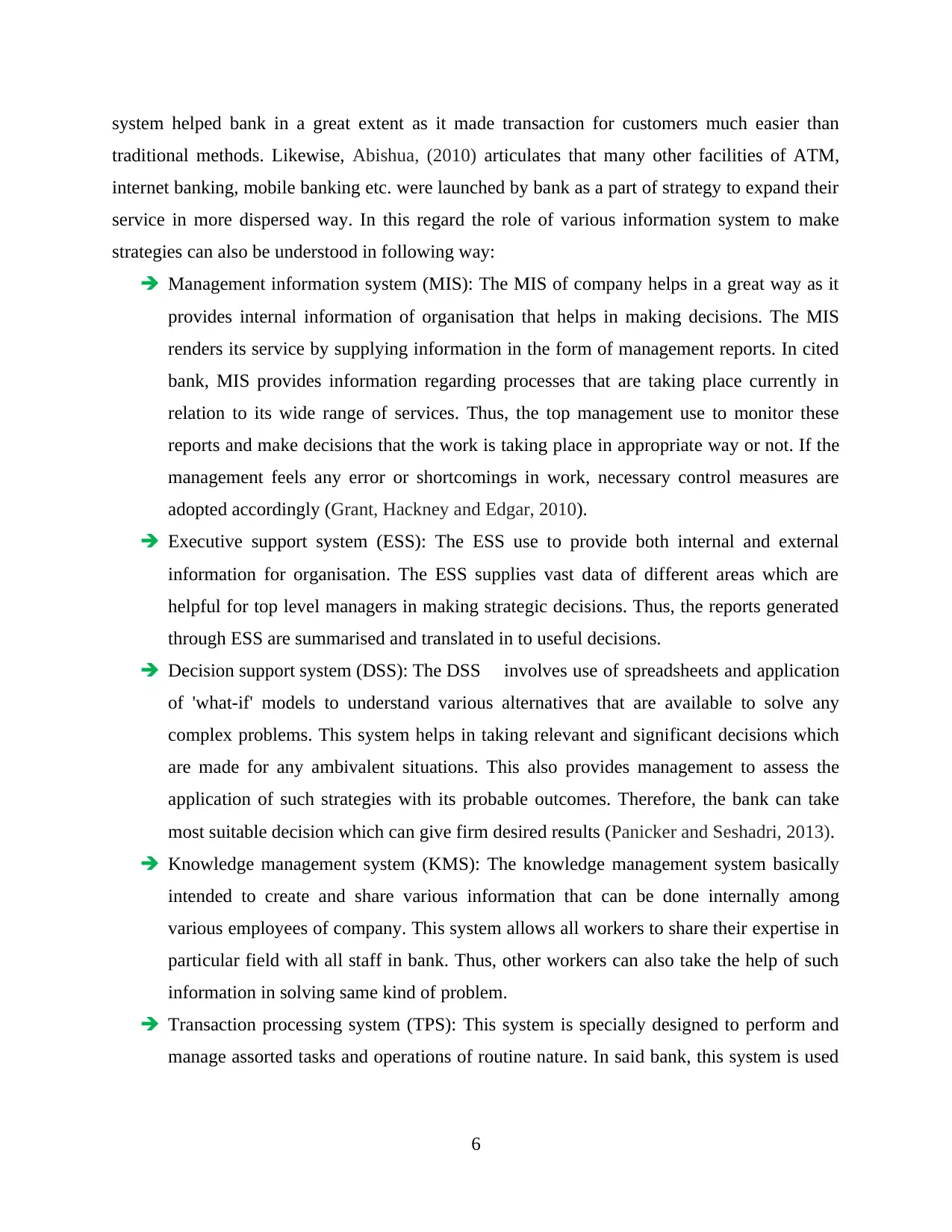
system helped bank in a great extent as it made transaction for customers much easier than
traditional methods. Likewise, Abishua, (2010) articulates that many other facilities of ATM,
internet banking, mobile banking etc. were launched by bank as a part of strategy to expand their
service in more dispersed way. In this regard the role of various information system to make
strategies can also be understood in following way:
Management information system (MIS): The MIS of company helps in a great way as it
provides internal information of organisation that helps in making decisions. The MIS
renders its service by supplying information in the form of management reports. In cited
bank, MIS provides information regarding processes that are taking place currently in
relation to its wide range of services. Thus, the top management use to monitor these
reports and make decisions that the work is taking place in appropriate way or not. If the
management feels any error or shortcomings in work, necessary control measures are
adopted accordingly (Grant, Hackney and Edgar, 2010).
Executive support system (ESS): The ESS use to provide both internal and external
information for organisation. The ESS supplies vast data of different areas which are
helpful for top level managers in making strategic decisions. Thus, the reports generated
through ESS are summarised and translated in to useful decisions.
Decision support system (DSS): The DSS involves use of spreadsheets and application
of 'what-if' models to understand various alternatives that are available to solve any
complex problems. This system helps in taking relevant and significant decisions which
are made for any ambivalent situations. This also provides management to assess the
application of such strategies with its probable outcomes. Therefore, the bank can take
most suitable decision which can give firm desired results (Panicker and Seshadri, 2013).
Knowledge management system (KMS): The knowledge management system basically
intended to create and share various information that can be done internally among
various employees of company. This system allows all workers to share their expertise in
particular field with all staff in bank. Thus, other workers can also take the help of such
information in solving same kind of problem.
Transaction processing system (TPS): This system is specially designed to perform and
manage assorted tasks and operations of routine nature. In said bank, this system is used
6
traditional methods. Likewise, Abishua, (2010) articulates that many other facilities of ATM,
internet banking, mobile banking etc. were launched by bank as a part of strategy to expand their
service in more dispersed way. In this regard the role of various information system to make
strategies can also be understood in following way:
Management information system (MIS): The MIS of company helps in a great way as it
provides internal information of organisation that helps in making decisions. The MIS
renders its service by supplying information in the form of management reports. In cited
bank, MIS provides information regarding processes that are taking place currently in
relation to its wide range of services. Thus, the top management use to monitor these
reports and make decisions that the work is taking place in appropriate way or not. If the
management feels any error or shortcomings in work, necessary control measures are
adopted accordingly (Grant, Hackney and Edgar, 2010).
Executive support system (ESS): The ESS use to provide both internal and external
information for organisation. The ESS supplies vast data of different areas which are
helpful for top level managers in making strategic decisions. Thus, the reports generated
through ESS are summarised and translated in to useful decisions.
Decision support system (DSS): The DSS involves use of spreadsheets and application
of 'what-if' models to understand various alternatives that are available to solve any
complex problems. This system helps in taking relevant and significant decisions which
are made for any ambivalent situations. This also provides management to assess the
application of such strategies with its probable outcomes. Therefore, the bank can take
most suitable decision which can give firm desired results (Panicker and Seshadri, 2013).
Knowledge management system (KMS): The knowledge management system basically
intended to create and share various information that can be done internally among
various employees of company. This system allows all workers to share their expertise in
particular field with all staff in bank. Thus, other workers can also take the help of such
information in solving same kind of problem.
Transaction processing system (TPS): This system is specially designed to perform and
manage assorted tasks and operations of routine nature. In said bank, this system is used
6
⊘ This is a preview!⊘
Do you want full access?
Subscribe today to unlock all pages.

Trusted by 1+ million students worldwide
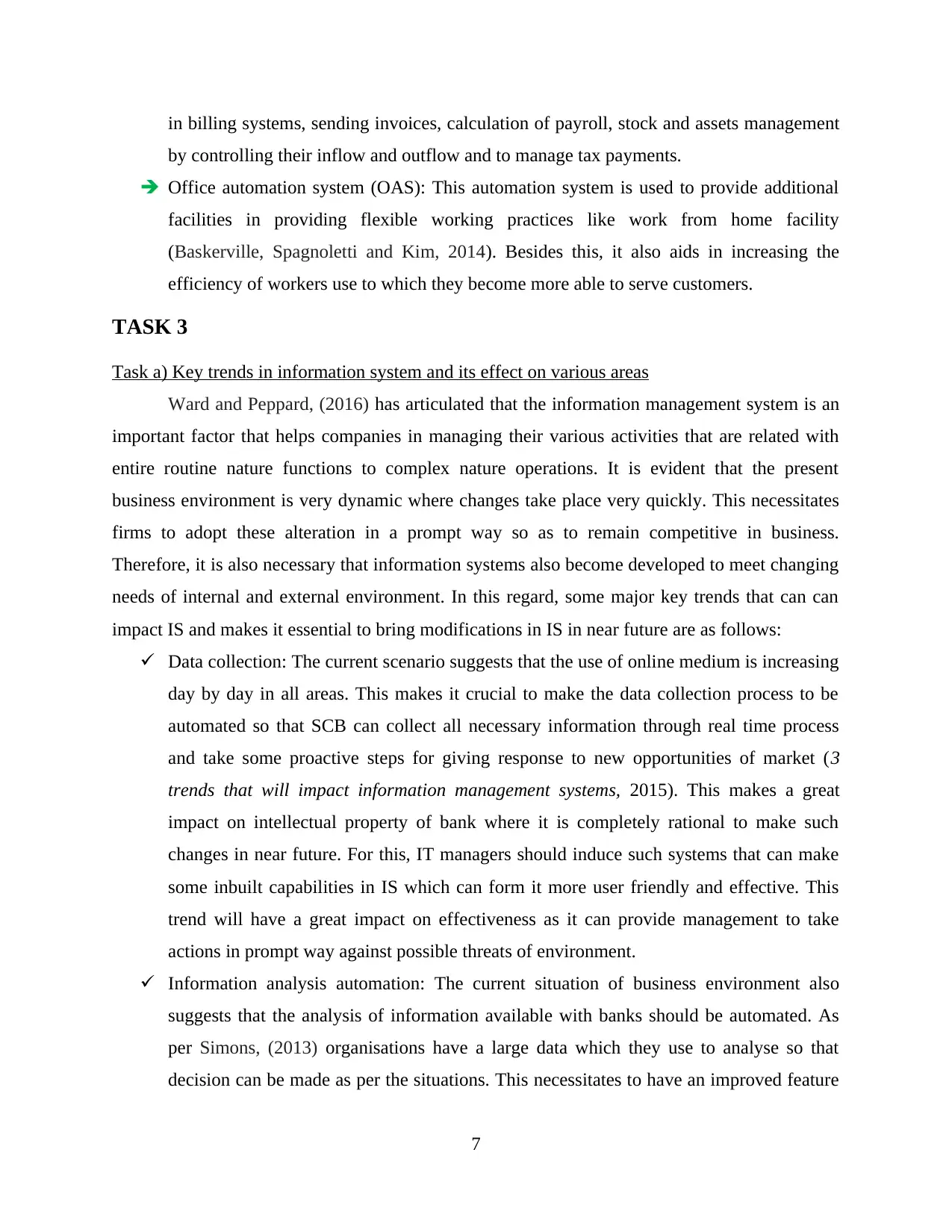
in billing systems, sending invoices, calculation of payroll, stock and assets management
by controlling their inflow and outflow and to manage tax payments.
Office automation system (OAS): This automation system is used to provide additional
facilities in providing flexible working practices like work from home facility
(Baskerville, Spagnoletti and Kim, 2014). Besides this, it also aids in increasing the
efficiency of workers use to which they become more able to serve customers.
TASK 3
Task a) Key trends in information system and its effect on various areas
Ward and Peppard, (2016) has articulated that the information management system is an
important factor that helps companies in managing their various activities that are related with
entire routine nature functions to complex nature operations. It is evident that the present
business environment is very dynamic where changes take place very quickly. This necessitates
firms to adopt these alteration in a prompt way so as to remain competitive in business.
Therefore, it is also necessary that information systems also become developed to meet changing
needs of internal and external environment. In this regard, some major key trends that can can
impact IS and makes it essential to bring modifications in IS in near future are as follows:
Data collection: The current scenario suggests that the use of online medium is increasing
day by day in all areas. This makes it crucial to make the data collection process to be
automated so that SCB can collect all necessary information through real time process
and take some proactive steps for giving response to new opportunities of market (3
trends that will impact information management systems, 2015). This makes a great
impact on intellectual property of bank where it is completely rational to make such
changes in near future. For this, IT managers should induce such systems that can make
some inbuilt capabilities in IS which can form it more user friendly and effective. This
trend will have a great impact on effectiveness as it can provide management to take
actions in prompt way against possible threats of environment.
Information analysis automation: The current situation of business environment also
suggests that the analysis of information available with banks should be automated. As
per Simons, (2013) organisations have a large data which they use to analyse so that
decision can be made as per the situations. This necessitates to have an improved feature
7
by controlling their inflow and outflow and to manage tax payments.
Office automation system (OAS): This automation system is used to provide additional
facilities in providing flexible working practices like work from home facility
(Baskerville, Spagnoletti and Kim, 2014). Besides this, it also aids in increasing the
efficiency of workers use to which they become more able to serve customers.
TASK 3
Task a) Key trends in information system and its effect on various areas
Ward and Peppard, (2016) has articulated that the information management system is an
important factor that helps companies in managing their various activities that are related with
entire routine nature functions to complex nature operations. It is evident that the present
business environment is very dynamic where changes take place very quickly. This necessitates
firms to adopt these alteration in a prompt way so as to remain competitive in business.
Therefore, it is also necessary that information systems also become developed to meet changing
needs of internal and external environment. In this regard, some major key trends that can can
impact IS and makes it essential to bring modifications in IS in near future are as follows:
Data collection: The current scenario suggests that the use of online medium is increasing
day by day in all areas. This makes it crucial to make the data collection process to be
automated so that SCB can collect all necessary information through real time process
and take some proactive steps for giving response to new opportunities of market (3
trends that will impact information management systems, 2015). This makes a great
impact on intellectual property of bank where it is completely rational to make such
changes in near future. For this, IT managers should induce such systems that can make
some inbuilt capabilities in IS which can form it more user friendly and effective. This
trend will have a great impact on effectiveness as it can provide management to take
actions in prompt way against possible threats of environment.
Information analysis automation: The current situation of business environment also
suggests that the analysis of information available with banks should be automated. As
per Simons, (2013) organisations have a large data which they use to analyse so that
decision can be made as per the situations. This necessitates to have an improved feature
7
Paraphrase This Document
Need a fresh take? Get an instant paraphrase of this document with our AI Paraphraser
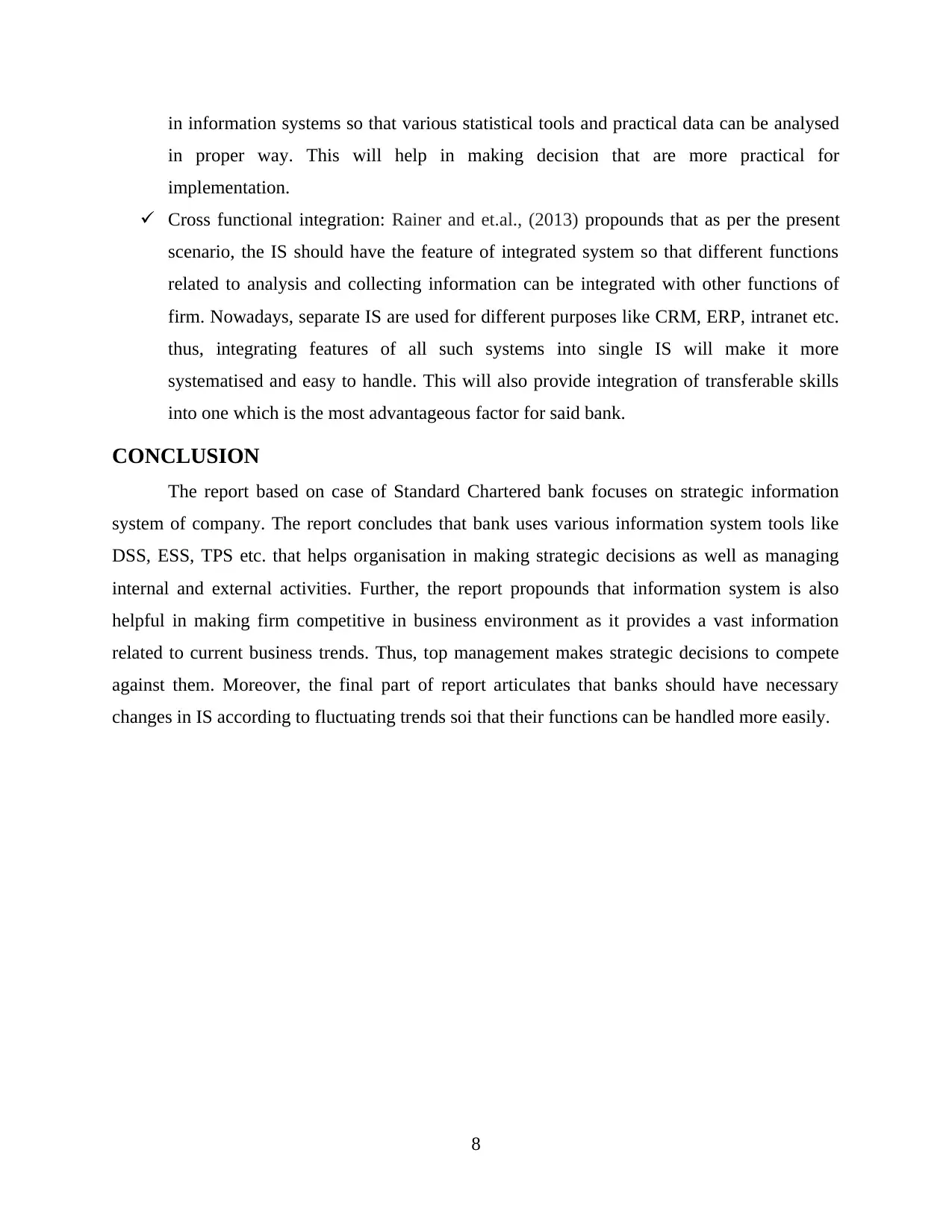
in information systems so that various statistical tools and practical data can be analysed
in proper way. This will help in making decision that are more practical for
implementation.
Cross functional integration: Rainer and et.al., (2013) propounds that as per the present
scenario, the IS should have the feature of integrated system so that different functions
related to analysis and collecting information can be integrated with other functions of
firm. Nowadays, separate IS are used for different purposes like CRM, ERP, intranet etc.
thus, integrating features of all such systems into single IS will make it more
systematised and easy to handle. This will also provide integration of transferable skills
into one which is the most advantageous factor for said bank.
CONCLUSION
The report based on case of Standard Chartered bank focuses on strategic information
system of company. The report concludes that bank uses various information system tools like
DSS, ESS, TPS etc. that helps organisation in making strategic decisions as well as managing
internal and external activities. Further, the report propounds that information system is also
helpful in making firm competitive in business environment as it provides a vast information
related to current business trends. Thus, top management makes strategic decisions to compete
against them. Moreover, the final part of report articulates that banks should have necessary
changes in IS according to fluctuating trends soi that their functions can be handled more easily.
8
in proper way. This will help in making decision that are more practical for
implementation.
Cross functional integration: Rainer and et.al., (2013) propounds that as per the present
scenario, the IS should have the feature of integrated system so that different functions
related to analysis and collecting information can be integrated with other functions of
firm. Nowadays, separate IS are used for different purposes like CRM, ERP, intranet etc.
thus, integrating features of all such systems into single IS will make it more
systematised and easy to handle. This will also provide integration of transferable skills
into one which is the most advantageous factor for said bank.
CONCLUSION
The report based on case of Standard Chartered bank focuses on strategic information
system of company. The report concludes that bank uses various information system tools like
DSS, ESS, TPS etc. that helps organisation in making strategic decisions as well as managing
internal and external activities. Further, the report propounds that information system is also
helpful in making firm competitive in business environment as it provides a vast information
related to current business trends. Thus, top management makes strategic decisions to compete
against them. Moreover, the final part of report articulates that banks should have necessary
changes in IS according to fluctuating trends soi that their functions can be handled more easily.
8
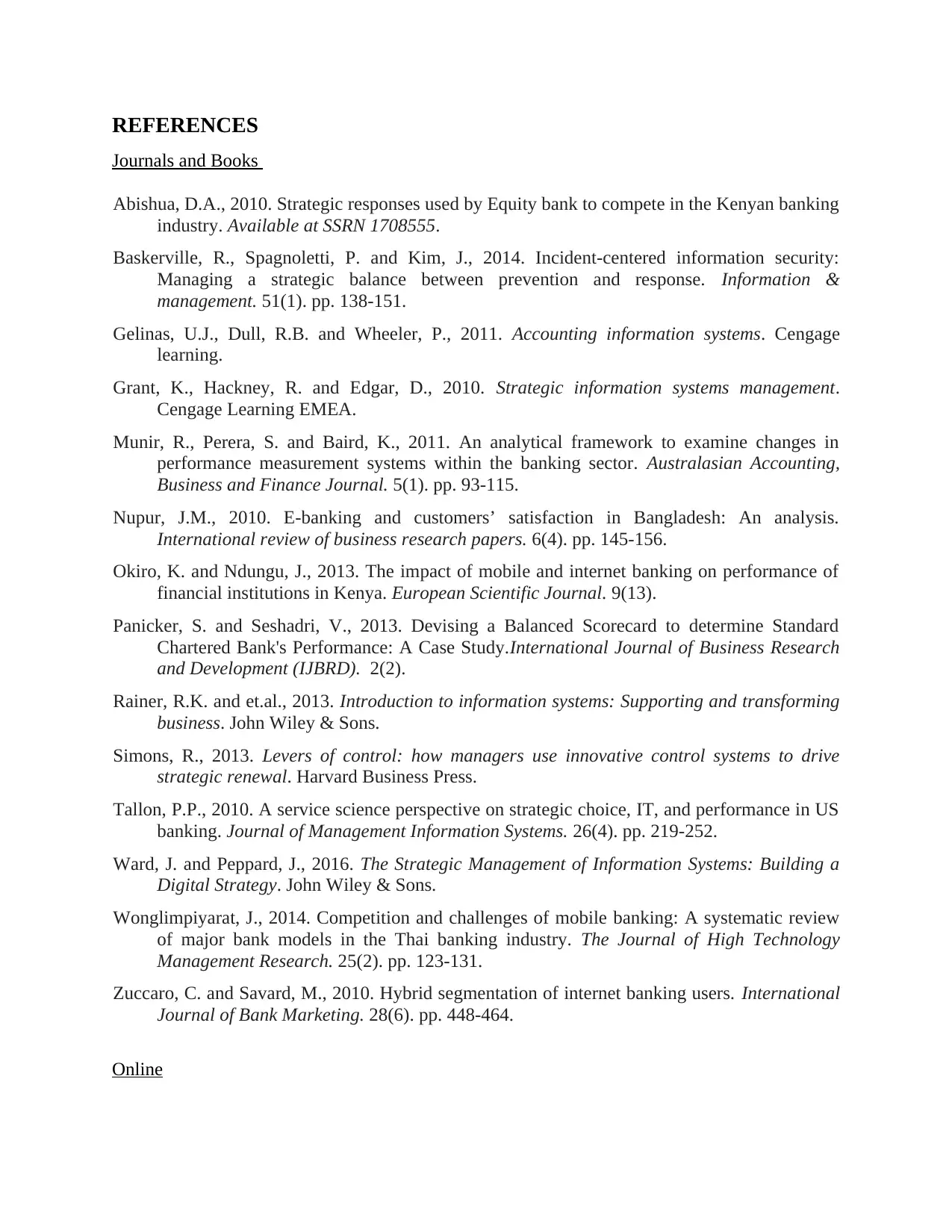
REFERENCES
Journals and Books
Abishua, D.A., 2010. Strategic responses used by Equity bank to compete in the Kenyan banking
industry. Available at SSRN 1708555.
Baskerville, R., Spagnoletti, P. and Kim, J., 2014. Incident-centered information security:
Managing a strategic balance between prevention and response. Information &
management. 51(1). pp. 138-151.
Gelinas, U.J., Dull, R.B. and Wheeler, P., 2011. Accounting information systems. Cengage
learning.
Grant, K., Hackney, R. and Edgar, D., 2010. Strategic information systems management.
Cengage Learning EMEA.
Munir, R., Perera, S. and Baird, K., 2011. An analytical framework to examine changes in
performance measurement systems within the banking sector. Australasian Accounting,
Business and Finance Journal. 5(1). pp. 93-115.
Nupur, J.M., 2010. E-banking and customers’ satisfaction in Bangladesh: An analysis.
International review of business research papers. 6(4). pp. 145-156.
Okiro, K. and Ndungu, J., 2013. The impact of mobile and internet banking on performance of
financial institutions in Kenya. European Scientific Journal. 9(13).
Panicker, S. and Seshadri, V., 2013. Devising a Balanced Scorecard to determine Standard
Chartered Bank's Performance: A Case Study.International Journal of Business Research
and Development (IJBRD). 2(2).
Rainer, R.K. and et.al., 2013. Introduction to information systems: Supporting and transforming
business. John Wiley & Sons.
Simons, R., 2013. Levers of control: how managers use innovative control systems to drive
strategic renewal. Harvard Business Press.
Tallon, P.P., 2010. A service science perspective on strategic choice, IT, and performance in US
banking. Journal of Management Information Systems. 26(4). pp. 219-252.
Ward, J. and Peppard, J., 2016. The Strategic Management of Information Systems: Building a
Digital Strategy. John Wiley & Sons.
Wonglimpiyarat, J., 2014. Competition and challenges of mobile banking: A systematic review
of major bank models in the Thai banking industry. The Journal of High Technology
Management Research. 25(2). pp. 123-131.
Zuccaro, C. and Savard, M., 2010. Hybrid segmentation of internet banking users. International
Journal of Bank Marketing. 28(6). pp. 448-464.
Online
Journals and Books
Abishua, D.A., 2010. Strategic responses used by Equity bank to compete in the Kenyan banking
industry. Available at SSRN 1708555.
Baskerville, R., Spagnoletti, P. and Kim, J., 2014. Incident-centered information security:
Managing a strategic balance between prevention and response. Information &
management. 51(1). pp. 138-151.
Gelinas, U.J., Dull, R.B. and Wheeler, P., 2011. Accounting information systems. Cengage
learning.
Grant, K., Hackney, R. and Edgar, D., 2010. Strategic information systems management.
Cengage Learning EMEA.
Munir, R., Perera, S. and Baird, K., 2011. An analytical framework to examine changes in
performance measurement systems within the banking sector. Australasian Accounting,
Business and Finance Journal. 5(1). pp. 93-115.
Nupur, J.M., 2010. E-banking and customers’ satisfaction in Bangladesh: An analysis.
International review of business research papers. 6(4). pp. 145-156.
Okiro, K. and Ndungu, J., 2013. The impact of mobile and internet banking on performance of
financial institutions in Kenya. European Scientific Journal. 9(13).
Panicker, S. and Seshadri, V., 2013. Devising a Balanced Scorecard to determine Standard
Chartered Bank's Performance: A Case Study.International Journal of Business Research
and Development (IJBRD). 2(2).
Rainer, R.K. and et.al., 2013. Introduction to information systems: Supporting and transforming
business. John Wiley & Sons.
Simons, R., 2013. Levers of control: how managers use innovative control systems to drive
strategic renewal. Harvard Business Press.
Tallon, P.P., 2010. A service science perspective on strategic choice, IT, and performance in US
banking. Journal of Management Information Systems. 26(4). pp. 219-252.
Ward, J. and Peppard, J., 2016. The Strategic Management of Information Systems: Building a
Digital Strategy. John Wiley & Sons.
Wonglimpiyarat, J., 2014. Competition and challenges of mobile banking: A systematic review
of major bank models in the Thai banking industry. The Journal of High Technology
Management Research. 25(2). pp. 123-131.
Zuccaro, C. and Savard, M., 2010. Hybrid segmentation of internet banking users. International
Journal of Bank Marketing. 28(6). pp. 448-464.
Online
⊘ This is a preview!⊘
Do you want full access?
Subscribe today to unlock all pages.

Trusted by 1+ million students worldwide
1 out of 13
Related Documents
Your All-in-One AI-Powered Toolkit for Academic Success.
+13062052269
info@desklib.com
Available 24*7 on WhatsApp / Email
![[object Object]](/_next/static/media/star-bottom.7253800d.svg)
Unlock your academic potential
Copyright © 2020–2025 A2Z Services. All Rights Reserved. Developed and managed by ZUCOL.





